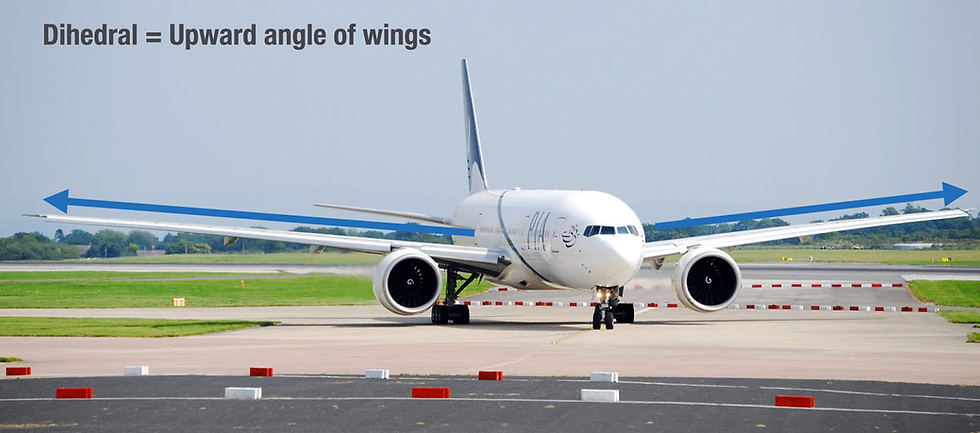Why Do Aircraft Wings Have Dihedral?
- Isha Federick
- Oct 11, 2017
- 2 min read
Why Do Aircraft Wings Have Dihedral?
What is Dihedral?
Dihedral sounds like one of those words you cringed at in math class, but it's actually pretty simple. Dihedral is the upward angle your aircraft's wings. Here's a great example of wing dihedral on a Boeing 777:
Why Do You Need Dihedral?
It all comes down to stability. If you didn't have dihedral, you'd spend more time keeping your wings level. When you bank an airplane, the lift vector tilts in the same direction as the bank. And when that happens, your airplane starts slipping in the same direction, in this case, to the right.
The problem is, if you have a straight-wing aircraft, there's no force that will bring the airplane back to wings-level flight without you intervening. And while that may be good for an aerobatic aircraft or fighter jet, it's not something you want in your general aviation aircraft or airliner.
How Dihedral Fixes The Problem
When you add dihedral, you add lateral stability when your aircraft rolls left or right. Here's how it works: let's say you're flying along and you accidentally bump your controls, rolling your plane to the right. When your wings have dihedral, two things happen:
1) First, your airplane starts slipping to the right. That means the relative wind is no longer approaching directly head-on to the aircraft, and instead is approaching slightly from the right. This means that there is a component of the relative wind that is acting inboard against the right wing.
2) Second, because the relative wind has the inboard component, and because the wings are tilted up slightly, a portion of the the relative wind strikes the underside of the low wing, pushing it back up toward wings level. What's really happening here is the low wing is flying at a higher AOA, and producing slightly more lift.
Wings with dihedral don't produce lift vertically. Instead, there's a vertical component, and a horizontal component. So when you're flying straight and level, your lift is not 100% vertical.
And, the same dihedral effect that keeps your wings level in turbulence, works against you when you try to roll right or left. When you put an aircraft into a bank, the dihedral effect constantly tries to return your wings to level. With enough dihedral, your roll rate is dramatically decreased.
Dihedral Is Pretty Useful
Dihedral lets you fly more hands off, even in turbulence. And a more hands off, stable airplane is good for everybody. Especially when you're trying to manage multiple things in the cockpit, like your checklist, your charts, and maybe even your coffee.
Source: Boldmethod










Comments